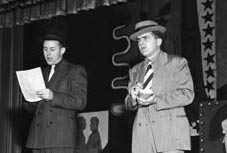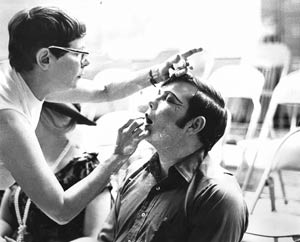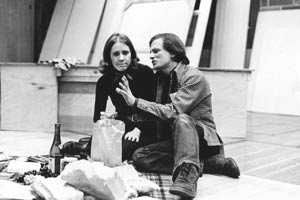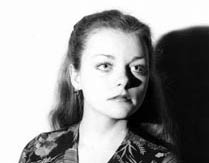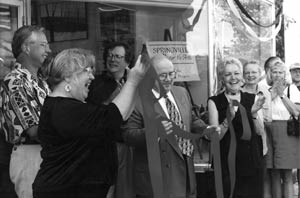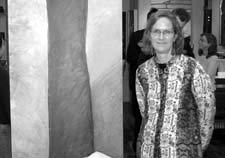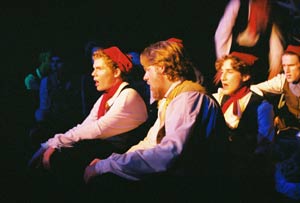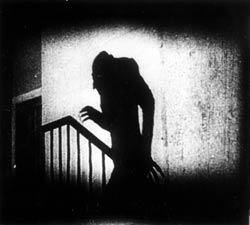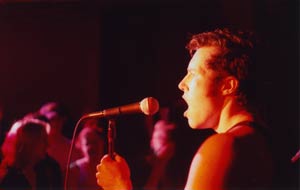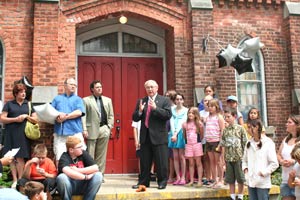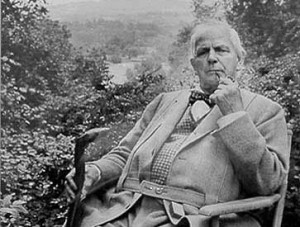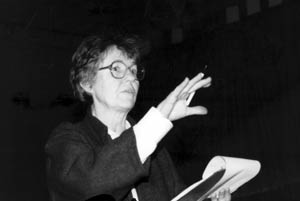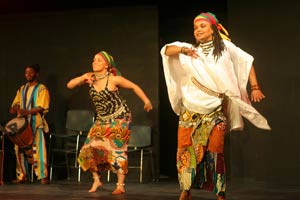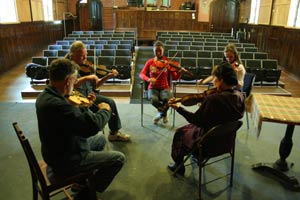SCA: History & Timeline
Beginning in 1951 with The Community Play and then The Community Musical in 1960, these large-scale productions raised funds for the Gerlach Student Loan Fund. They were originally produced by the Springville-Griffith Faculty Association under the direction of Dick Hutchinson but soon involved people from across the region. The success of the program drives the construction of an auditorium at the high school completed in time for The King and I in 1965. By the 1970 production of My Fair Lady, the Community Musical boasts working with 1,000 students, 300 teachers, 400 adults and 17,000 attendees.
Birth of the Springville Players
1965: The Springville Players form to support the Community Musical and produce additional plays. Early productions include Mary, Mary and The Odd Couple (shown with Doug Bailey as Roy). Stage time is increasingly sparse at the new auditorium and requires that all sets are assembled and disassembled every night. Tickets are sold at a local furniture store. Membership in the organization costs $4.25.
Move to Elementary School
1973: The Players move their productions to the Springville Elementary School stage as a more permanent home. Averaging two café style productions a year with some additional play readings and summer events, the move is a major shift for the organization. Lighting equipment is purchased and the Players’ productions become more independent and artistically adventurous. The organization is officially incorporated a year later.
Over fifty productions later, The Springville Players continue to attract talent and audiences to their performances. In addition to the work at the school, productions are staged regionally at area civic clubs, a preschool, ski resort and Erie Community College. Ticket prices at this time are advertised as $4 adults, $2 Children.
After a series of Town Hall Meetings, the Springville Players collaborate with visual artists and performers to create a community arts center in a vacant shoe store. The construction attracts scores of volunteers. The Center features a fifty seat “shoe box” theater and gallery and workshop space. The opening on May 30, 1998 advertises folk music, painting classes, classical duets, improv theater and local artists on exhibition.
The new gallery program attracts visual artists from across several counties. Ten exhibitions are displayed yearly and a small shop area sells locally made artisanal crafts. Early exhibits set the tone for the program for years to come; local artists in solo exhibits, juried open calls, work with schools and other organizations, and workshops for artists of all ability levels.
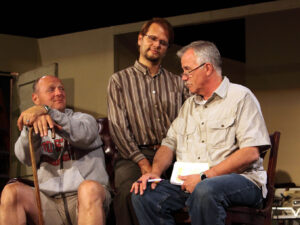
Growing Organization
2001: New committees are formed to represent the growing interests at the Center and Bylaws are updated to accommodate the expansion. A grant is received to purchase a computer, finally ending the decades-old practice of hand written financial spreadsheets and minutes.
2003: After the hit production of Les Miserables, a musical staged by high school and college students becomes a staple of the summer calendar. Incubated by S.L.A.M., an informal club of “Students Loving Art and Music” at Springville-Griffith, the shows soon attract students from other districts. The program has given rise to many professional performers.
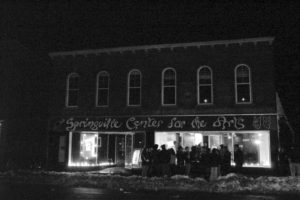
Name Change
2004: The Arts Center joins the Western New York cultural community participating in nonprofit training by the Buffalo Arts Council. The name legally changes to Springville Center for the Arts, Inc.
First Director
Flourishing programs see the organization’s annual budget double with scores of volunteers producing concerts, serving as receptionists, hanging exhibits and staging theater. In 2004, independent of outside funding assistance, the Board hires Mimo Fried, the first Executive Director.
With a screening of Become the Sky, Cinema is added to the palette of events at the center. Programming focuses on independent shorts, international films and silent cinema with live accompaniment. Films screen outdoors as well; Cinema Paradiso on the side of the town hall, a swamp monster B-movie at the community pool and Buster Keaton films with George Eastman House accompanist Dr. Philip Carli.
Fulfilling the organization’s mission to serve all segments of the community, Art Camp and Theater Camp begin a tradition of summer classes for children. Working alongside adult artists, young thespians fill the stage while young artists fill the gallery with clay creatures, handmade percussion and mutated shoes. Later partnership with Springville Youth Incorporated greatly expanded the program.
Concerts continue to grow in popularity with local and regional acts. Rock shows produced by teenagers introduce a new generation to the Arts Center and expose the power of the internet and social media. With a record attendance of over five hundred at a concert produced by a school business class, young people prove that makeup is no longer just for theatrical productions.
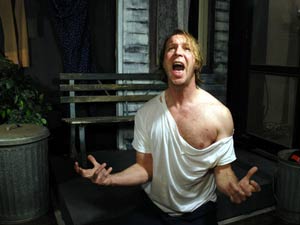 Expanding Programs Crowd Center
Expanding Programs Crowd Center
With a drastic increase in attendance and the number of productions over the course of the Center’s eight years, more space is needed. Annual programming includes three major theater productions plus the SLAM summer musical and other readings, ten exhibits, multiple adult and youth workshops, eight film screenings, concerts, recitals and community events. The Board eyes available real estate and prepares the organization to become ready for a capital campaign.
After raising $100,000 from the membership in just three months, a Baptist Church built in 1869 is purchased to become the new permanent home of Springville Center for the Arts. An army of volunteers prepares the structure, removing debris, constructing a stage, gallery walls and kitchen. The key turning ceremony gives the public a preview of the “interim setup” with many state and local officials present.
The Main Street exhibition space closes August 31, 2007 and opens the next day in the church. Named after local architect, landscape designer and artist Harold L. Olmsted, the transition to the new space is supported by relations, friends and the many people he influenced over the years. The first exhibit features photographs by notable area residents that are auctioned off at a “black tie and hard hat” event.
Theater productions move to the temporary set up in the ninety-seat Carol Mongerson Theater. The local school donates seating which originated with the Community Musical program forty years earlier. Mongerson, a local playwright, director and artist was key to the formation of the center. Like many, she had long dreamed of a permanent space but sadly passed before it could be realized.
With a larger house and stage, new possibilities arise and the Arts Center features artists from outside of the area. Programs include African dance, classical, New Orleans blues, and contemporary percussion.
Programming continues to encourage direct access to the arts. Theater productions engage dozens of participants. Workshops in visual and performing arts reach seniors, children, the experienced and the new. Local residency programs begin and new collaborations with arts providers in the region pairs professionals with nonprofessionals working together on projects.
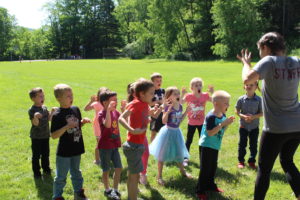
Summer Internship Program
2011: An annual summer program is created, bringing college students from around the US to teach and perform in Springville. Starting out with four theater interns, the program is expanded to include visual arts, media, arts administration interns. Each year, these interns teach workshops, direct children’s theater shows, create public art and more.
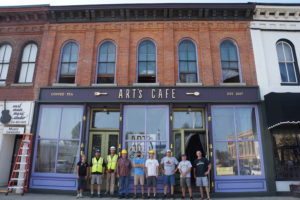 Art’s Cafe Acquisition
Art’s Cafe Acquisition
With a successful campaign to raise over $30,000 in 30 days with an online platform, SCA acquires 5 East Main Street and begins a long-term project to transform the collapsed structure into artist residencies, workshop space, public green roof and a cafe. Through a public shareholder program and historic tax credits, major construction on the space in completed in December 2019, allowing art workshops to begin in basement workshop and the Backdoor Bakery to open in September 2020, as a stepping stone to the full cafe. Read more about the project here.
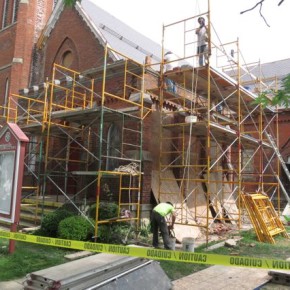 Classroom Addition & Exterior Restoration
Classroom Addition & Exterior Restoration
2012-2017: With the assistance of the New York State Historic Preservation Office, NY Homes & Community Renewal, Empire State Development, Community Foundation of Greater Buffalo, New York State Council on the Arts, The County of Erie, The Springville-Griffith Community Education Foundation, Western New York Foundation, Baird Foundation, John R. Oishei Foundation, M&T Bank and many individual donations, the Center begins phase two of the building project. Exterior repairs to roofing and masonry stabilize the building. A second story classroom addition named for volunteer and artist Frances Vacanti provides dedicated classroom space for the growing educational programs.
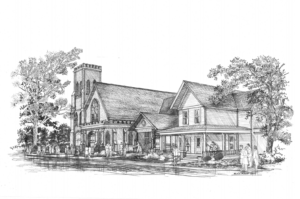
Mongerson Theater & Program Expansion
Capping off several million dollars in renovations, the theater will be completed in 2022. The project focus on making the building accessible, efficient and comfortable, while providing increased programs for all ages and spaces for the arts in the Springville Area for generations to come.











